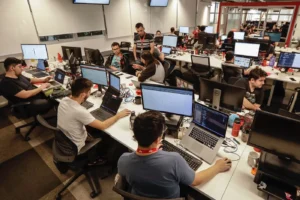Setting the temperature in your room before you even get home, monitoring your business remotely, searching for your favorite series via voice command and making payments with your watch: all of this is now within our reach thanks to the internet of things.
Understand the concept of the internet of things, its applications, advantages and disadvantages. Furthermore, discover in this text how it has been implemented in Brazil, with the National Internet of Things Plan, and in different sectors of society around the world.
What is the Internet of Things?
The Internet of Things (IoT) is the concept of a technological ecosystem in which objects – from coffee machine The tractors – connect to the internet to perform tasks. This ranges from the provision of services in everyday life, to industries, cities, etc.
These portable electronic devices, or gadgets, can be controlled and monitored remotely through applications and software installed on external gadgets. Examples of this are smartphones, tablets and computers.
The term internet of things, therefore, encompasses everything that can be connected to the internet in addition to computers and smartphones. In other words: household appliances, vehicles, houses and even people and animals, since chips and biochips are already a reality.
The connection between these objects makes the collect, the processing or transmission of data to perform one or more tasks that improve and facilitate everyday life, the economy, and cities. In short: life in general.
All Internet of Things products are composed of hardware (chip, sensor or antenna) and software (programs, applications). In the Internet of Things, the internet connection is made wirelessly (Wi-Fi, Bluetooth), and the data is stored in clouds.
The impact of the internet of things on education
Never before education had been as impacted by digital technologies as it has been since 2020 with the Covid-19 pandemic.
Remote classes, online tests, Zoom presentations: the social distancing imposed by the pandemic impacted teaching from pre-school to postgraduate studies.
In this context, the internet of things has played a fundamental role in interactions between students and teachers.
Interactive content through the use of applications and e-learning platforms on tablets, computers and cell phones expands and improves the virtual learning environment (VLE).
Cameras with facial identification can help control attendance and absences and student safety.
Internet of Things Examples
Personal items such as internet-connected and multifunctional watches, glasses and bracelets, known as wearables, are examples of the internet of things.
From controlling sleep quality to paying for purchases, these gadgets have gained popularity and market share, making life easier in many ways. Just like these, many other devices will be increasingly present in everyday life.
See below some examples of the internet of things.
The application of the internet of things created the concept of smart cities and homes, in addition to industry and agriculture 4.0.
In that regard, smart cities (smart cities) are those that promote quality of life, sustainable development, inclusion and security. Furthermore, they offer services with more agility and transparency through technologies such as the internet of things.
Monitoring cameras, smart traffic lights, air quality sensors and service applications are resources used to make life easier for residents and visitors to smart cities.
Smart homes rely on the practicality of the internet of things.
Gas leak detectors that issue alerts and notifications to your cell phone, lamps, switches, thermostats and locks controlled by applications, refrigerators, coffee makers and toasters with Wi-Fi, speakers activated by voice command, cameras monitored remotely are some of the examples of internet of things in everyday items.
The internet of things is also present in the productive sectors of the economy, such as industry, mining, livestock and agriculture.
Chips used to monitor animals, automated tractors and harvesters, intelligent irrigation systems, drones are applications of the internet of things in agriculture and livestock.
In mining companies, the internet of things transforms production processes, facilitating real-time monitoring of drillings and allowing remote tracking for employee safety.
In medicine, the use of biochips implanted in humans is already a reality in the United States, where registrations of these devices are growing.
The size of a grain of rice, the biochip can be implanted in patients undergoing radiotherapy treatments to monitor the level of radiation
Internet of Things: advantages and disadvantages
The internet of things can be considered the main technological development of the 21st century. It affects life in all aspects, bringing several benefits.
However, some technological and economic challenges result in disadvantages when thinking about the internet of things.
See below some advantages of the internet of things.
- Enables the efficient use of natural and material resources;
- Minimizes human effort in various aspects of life;
- Promotes the marketing of products and services in real time;
- Helps to reduce costs in the industry;
- Automates daily tasks;
- Increases efficiency and agility of processes and time savings;
- Promotes quality of life.
The disadvantages of the internet of things are mainly linked to data security. But there are others that must be taken into consideration.
- The lack of an international compatibility standard for devices;
- High system complexity can generate failures between processes;
- Devices can be affected by security and privacy breaches and flaws.
Understand the national internet of things plan
With the approval of the National Internet of Things Plan, Brazil took an important step in the face of digital transformations that impact the entire world, from industry to human relationships.
According to experts, Brazil is the largest and most developed internet of things market in Latin America, but there are still many challenges in public and private initiatives.
The National Internet of Things Plan, established by Decree 9,854, of 2019, seeks to implement and develop the Internet of Things in the country. The idea is to make services more efficient through IoT, making life easier and better for the population.
Among the measures foreseen by the National Internet of Things Plan are:
- Creation of innovation platforms in health, cities and countryside;
- Financing of technology centers;
- Creation of an IoT entrepreneurial seal;
- Promotion of grants to researchers;
- Incentive for startups.
Read too:
Unicorn Startup: Everything you need to know
Internet of Things in Industry 4.0
Industry 4.0 – or Fourth Industrial Revolution – is the term used to refer to automation and data exchange technologies that are part of the industrial process.
Among these technologies are the Internet of Things, cyber-physical systems, big data, cloud storage.
Thanks to the internet of things and cloud storage, machines can work alone and be controlled remotely, that is, they are automated.
Factory automation has been implemented in different production sectors, such as the automobile industry and agriculture, in several countries in the last decade.
In this way, industry 4.0 is characterized by the combination of digital, physical and biological technologies, such as nanotechnology, biotechnology, artificial intelligence, robots, drones and 3D printers.
The future, according to experts, will be smart factories, whose systems self-regulate. The speed, impact and reach of the internet of things in industry 4.0 is something humanity has never seen before.


